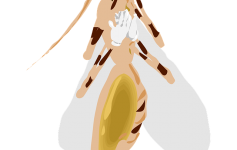We’ve discussed previously the importance of the microbiome. You can click here if you need a quick intro or refresher on the role of the bugs that line our insides and outsides. I also just wrote a blog on why the topic of the microbiome continues to be at the forefront of scientific research. You want to make sure you check that out to discover why it is important to consider that killing them off may not be the best idea and how to prevent growing the bad guys to begin with a healthy gut.
“Anti” = against. “Biotic” = Life. Antibiotic. What happens when we kill our belly bugs in an attempt to rid of disease? (I wrote about this here. This is why I like the use of essential oils to modulate the immune response and keep happy bugs in place.)
Do Antibiotics Blunt Breastfeeding Benefits?
Health Day recently reported on a study linking antibiotics to reduced breastfeeding benefits:
Researchers found that babies who were prescribed antibiotics while they were breast-feeding or shortly afterward were prone to infections and obesity.
“In breast milk, unlike in formula milk, the infant receives bacteria from the mother and specific sugar components that promote the growth of certain [gut] bacteria,” explained lead researcher Katri Korpela, from the immunobiology research program at the University of Helsinki in Finland.
The finding indicates that the health benefits of breast-feeding are largely due to how it helps a baby develop intestinal bacteria (microbiota), and that antibiotics disturb that development, she said.
Drugs and Bug Effects in Children- Antibiotics Effect Baby’s Microbiome
A June 15, 2016 article in Science Transitional Medicine reported the following on the significance of a new study:
Despite widespread use of antibiotics in children, the effects of antibiotic exposure on the developing infant gut microbiome have remained underexplored. Here, Yassour et al. present a longitudinal study capturing how the gut microbiome responds to and recovers from antibiotic perturbations. Antibiotic-treated children had less stable and less diverse bacterial communities. Antibiotic resistance genes within the guts of these children peaked after antibiotic treatment but generally returned rapidly to baseline. Delivery mode (vaginal versus cesarean) also had strong long-term effects on microbial diversity. These data give insights into the consequences of early life factors such as birth mode and antibiotic treatment on the infant gut microbiome.
Antibiotics, Birth mode, and Diet Shape Microbiome Maturation During Early Life
A second study, released on the same day in Science Transitional Medicine was summarized as follows:
The intestinal “microbiota,” that is, the community of microbes inhabiting the human intestinal tract, undergoes many changes during the first 2 years of life. Bokulich et al. now show that this pattern of development is altered in children who are delivered by cesarean section, fed formula, or treated with antibiotics, compared to those babies who were born vaginally, breast-fed, or unexposed to antibiotics. Future studies will determine whether these disturbances influence the health of these babies.
Can Antibiotics Make More Bad Bugs Grow?
A new study released on June 15, 2016 in Nature was reported by Science Daily. The article states:
Gastroenteritis is a common side effect of taking antibiotics. While diarrhea may be mild and clear up after antibiotic therapy is completed, in some cases, it can lead to colitis, an inflammation of the colon, or more serious conditions that cause abdominal pain, fever and bloody diarrhea.
Bäumler’s research found that oral antibiotic treatment increased the synthesis of a host enzyme that generates nitric oxide radicals, which can oxidize sugars into sugar acids, such as galactarate, a key driver of Salmonella growth.
FEEDING HAPPY BUGS
Walnuts for Belly Bugs and Colon Health
According to a study by the University of Connecticut, found in Cancer Prevention Research, as reported by Science Daily:
To figure out why walnuts were beneficial, the UConn Health team collaborated with Dr. George Weinstock and colleagues at The Jackson Laboratory. Weinstock’s lab took fecal samples from the mice and analyzed the communities of bacteria living in their digestive tracts. They found that walnut consumption tended to push the gut microbiome toward an ecology that was potentially protective against cancer. It’s not clear exactly how this works, but there are clues. For example, previous research has shown that some gut bacteria digest fiber into compounds with anti-inflammatory properties that may reduce tumor initiation. The microbiome analyses also reflected interesting differences between male and female. Males on walnut-free diets tended to have less-diverse gut flora than females. Adding walnuts to the diets of male mice brought their microbiomes closer to those of female mice on either of the diets. Whether this change contributes to the protection seen in male mice remains to be determined.
The Competition and Cooperation of Diet in Our Bodies with Our Bugs
A wonderful article in the Annals of the New York Academy of Sciences describes how some foods make our gut bugs and our cells work together for health, and others cause a competition to ensue:
Diet has been known to play an important role in human health since at least the time period of the ancient Greek physician Hippocrates. In the last decade, research has revealed that microorganisms inhabiting the digestive tract, known as the gut microbiota, are critical factors in human health. This paper draws on concepts of cooperation and conflict from ecology and evolutionary biology to make predictions about host-microbiota interactions involving nutrients. To optimally extract energy from some resources (e.g., fiber), hosts require cooperation from microbes. Other nutrients can be utilized by both hosts and microbes (e.g., simple sugars, iron) in their ingested form, which may lead to greater conflict over these resources. This framework predicts that some negative health effects of foods are driven by the direct effects of these foods on human physiology and by indirect effects resulting from microbiome-host competition and conflict (e.g., increased invasiveness and inflammation). Similarly, beneficial effects of some foods on host health may be enhanced by resource sharing and other cooperative behaviors between host and microbes that may downregulate inflammation and virulence. Given that some foods cultivate cooperation between hosts and microbes while others agitate conflict, host-microbe interactions may be novel targets for interventions aimed at improving nutrition and human health
One example is the harmful fats and sugars found in the Western diet, which is consumed by both the host (our cells) and pathogenic bacteria. The authors state, “… these results suggest that diets high in fats and refined sugar can (1) fuel harmful ecological change in the gut, and (2) escalate the intensity of host countermeasures in the form of inflammation and possibly altered glucose metabolism.”
IS THE SOLUTION TO JUST SWALLOW BUGS?
Probiotics may be helpful for many, but remember, we all have our own unique microbiome related to our diet, environment, and lifestyle factors. Furthermore, it is now understood that it’s more about the immune modulation of using specific bacteria, which actually create more diversity in our guts and better metabolites, rather than haphazardly throwing down billions or trillions of high dose probiotics that may or may not be a match to our own unique microbiome footprint.
This is why I usually suggest a reasonable amount of probiotic counts with multi-strains that have been clinically tested for immune modulation. If I can, I try to find a probiotic with specific bugs that have been shown in some studies to modulate specific issues in my clients. Unfortunately, the research still isn’t perfect in clinical trials, but we are getting there.
So, the best way to keep a healthy gut is diet and lifestyle. Then, it’s finding a probiotic that is right for you. If your gut isn’t happy still, and you are taking a probiotic, that’s probably “not it.” The good news is; they are pretty darn safe…but if they aren’t working, it may be a waste of bugs and dollars.
References:
http://aem.asm.org/content/early/2016/06/06/AEM.01235-16.abstract?sid=27a3733b-f6c5-4acb-bfbb-deed96337ac1
https://www.sciencedaily.com/releases/2016/06/160604052109.htm
http://www.cmghjournal.org/article/S2352-345X(16)30043-1/fulltext
https://www.sciencedaily.com/releases/2016/06/160620191705.htm
http://medicalxpress.com/news/2016-06-indicator-chronic-fatigue-syndrome-gut.html
https://www.sciencedaily.com/releases/2016/06/160616140723.htm
http://www.nature.com/nature/journal/v534/n7606/full/nature18309.html
http://www.chem.ucla.edu/dept/Faculty/merchant/pdf/microbial.pdf
http://www.nature.com/nature/journal/v534/n7606/full/nature18301.html
http://www.medscape.com/viewarticle/864972 src=WNL_topol_1on1_MSCPEDIT&uac=146852BY&impID=1133796&faf=1#vp_3
https://consumer.healthday.com/women-s-health-information-34/breast-feeding-news-82/antibiotics-may-blunt-breastfeeding-s-benefits-711894.html
http://stm.sciencemag.org/content/8/343/343ra81
http://stm.sciencemag.org/content/8/343/343ra82
https://www.sciencedaily.com/releases/2016/06/160615134749.htm
https://www.sciencedaily.com/releases/2016/06/160602162940.htm
http://onlinelibrary.wiley.com/doi/10.1111/nyas.13118/full



